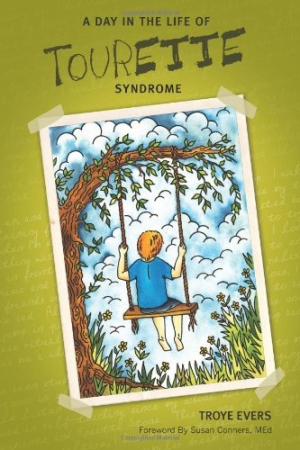A Day in the Life of Tourette Syndrome
Remember your friend from high school who cleared his throat loudly every ten seconds? You may have thought he was doing it on purpose; maybe it seemed like he was looking for attention. Chances are that his endless coughing was involuntary and the last thing he wanted was for you to notice it. Chances are he had a neurological disorder known as Tourette Syndrome (TS). With A Day in the Life of Tourette Syndrome, Troye Evers brings to light the real-life stories of TS patients and how it feels to do battle with brain and body on a daily basis.
Seventeen TS patients, ranging in age from fifteen to forty-three, chronicle their early symptoms, the rocky road to diagnosis, and the many treatments they have tried. The age range reflects the typical progression of TS, which tends to become prominent during the teen years and often wanes in middle age, according to the National Institute of Neurological Disorders and Stroke. Evers also includes his own story, which he has examined extensively and shares in the form of a screenplay as well as a blog.
The similarity of the stories told in each mini-memoir in Evers’s book is striking. Most TS patients start having tics, or uncontrollable urges to move or vocalize, as young children. Their parents understandably become concerned and thus begins years of doctor visits, tests, and often several misdiagnoses before the correct diagnosis of TS is reached. Some are relieved to have a name for their experience, but nearly every TS sufferer who is open about his or her disorder reports being the subject of jokes about vocal obscenities even though that symptom, called coprolalia, is present in less than 10 percent of cases, as Evers explains.
Although the students, actors, therapists, comedians, medical assistants, and others who share their stories here have unique personalities and life trajectories, their experiences related to Tourette Syndrome are quite similar. The first-person narration helps their accounts maintain some individuality, but incidents of school bullying, accompanying anxiety disorders, and failed trials of medicines like Tenex, Xanax, and Haldol are repeated so often that the stories begin to blend together. Evers’s effort to find the common ground among TS sufferers sometimes succeeds at the expense of articulate characterization.
This is, though, essentially a book about people. It is not a neurology textbook; one won’t find nervous system diagrams or brain-scan images here. Instead of a medical explanation, Evers seeks a human explanation. He shows how TS affects average people living their everyday lives. While A Day in The Life of Tourette Syndrome could be a useful addition to college psychology classes, it seems most appropriate for the personal libraries of families affected by the intense challenges of this disorder.
Reviewed by
Sheila M. Trask
Disclosure: This article is not an endorsement, but a review. The publisher of this book provided free copies of the book and paid a small fee to have their book reviewed by a professional reviewer. Foreword Reviews and Clarion Reviews make no guarantee that the publisher will receive a positive review. Foreword Magazine, Inc. is disclosing this in accordance with the Federal Trade Commission’s 16 CFR, Part 255.

